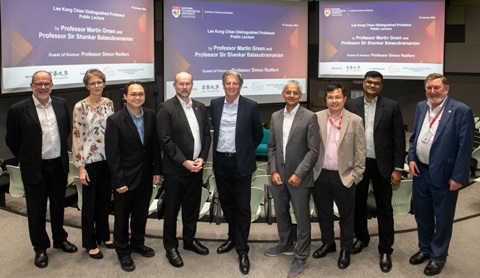A Sustainable Solar Strategy

Singapore is pushing hard for broad adoption of solar energy and reduction of greenhouse gas emissions in the coming years. However, although sunlight is abundant, great innovation is needed to develop solar panels that can maximise the island’s limited space.
The NTU team led by Prof Subodh Mhaisalkar (Executive Director of ERI@N, NTU), Prof Sum Tze Chien (IAS Director; Associate Dean of Research, College of Science) and Associate Prof Nripan Mathews (IAS Associate Director; Provost's Chair in Materials Science
and Engineering) are developing two different approaches based on perovskites - materials that have emerged as promising alternatives to silicon in solar cell applications. One way is to make conventional large-scale ‘tandem’ solar modules
that combine perovskite and silicon-based solar cells. In July 2020, the team had fabricated solar cell modules of 21 cm2 size with record power conversion efficiencies of over 18%. Units of this size can be assembled into commercially
useful panels, and the team is employing a commonly used evaporation-based process to manufacture their cells.
The team is also developing perovskite-coated glass solar panels that could turn every window in Singapore into a generator. These are made through essentially the same screen-printing process used to make T-shirts, which simplifies production greatly, but doesn’t account for other major materials challenges.
Conventional perovskites do not function well under humid conditions. Hence, if the team can get perovskite solar cells to function well in Singapore, they can be applied anywhere. The NTU’s research work is thus particularly well-situated for demonstrating the sustainability of the solar cell designs. Click here to read more.














/enri-thumbnails/careeropportunities1f0caf1c-a12d-479c-be7c-3c04e085c617.tmb-mega-menu.jpg?Culture=en&sfvrsn=d7261e3b_1)

/cradle-thumbnails/research-capabilities1516d0ba63aa44f0b4ee77a8c05263b2.tmb-mega-menu.jpg?Culture=en&sfvrsn=1bc94f8_1)

7e6fdc03-9018-4d08-9a98-8a21acbc37ba.tmb-mega-menu.jpg?Culture=en&sfvrsn=7deaf618_1)






